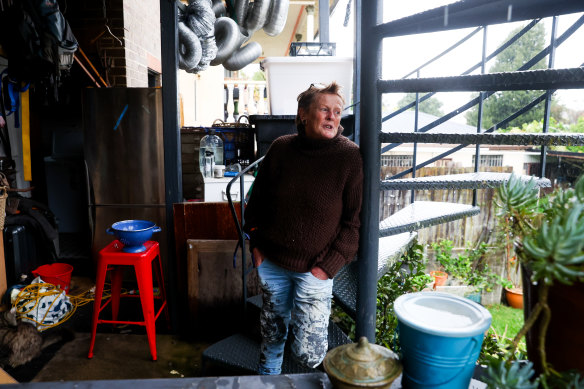This was published 7 months ago
Gray pays $115 a week in rent. But there’s a catch
With a weekly rental bill of just $115 to live in Newtown, Gray Horwitz has beaten Sydney’s housing crisis.
The PhD student lives with four other people in an apartment in the Stucco Housing Co-operative, which caters mainly to full-time students at the University of Sydney.
“It is much cheaper than similar nearby housing in part because the residents work to maintain the building,” Horwitz said.

PhD student Gray Horwitz lives in the Stucco Housing Co-operative in Newtown.Credit: Jessica Hromas
City of Sydney Greens councillor Sylvie Ellsmore said co-ops play a big part in keeping housing affordable in cities in Europe.
“When housing is public or collectively run by the people who live in it – as a home, not a commercial investment – it keeps prices down,” she said.
What is a housing co-op?
A co-op is a business or organisation owned and controlled by members to meet their shared needs.
Western Sydney University professorial research fellow Louise Crabtree-Hayes said co-operatives are defined by a “one member, one vote” principle, which gives residents a say in the management of their co-op.
Housing co-ops can be townhouses and small buildings with a handful of units or large complexes with hundreds of units. Some co-ops are rental while others are member-owned.
Co-operatives operate according to seven international principles of co-operation based on self-help, self-responsibility, democracy, equality, equity, and solidarity.
“Many of those are not found in other forms of tenure,” said Crabtree-Hayes, the co-author of The Value of Housing Co-operatives in Australia.
How do they work?
Community housing provider Common Equity chief executive Nick Sabel said housing co-operatives are run by the people who live in them.
“It is a housing model that engages residents in decisions that affect their lives and facilitates communities to deliver their own housing their own way,” he said.
At Stucco, residents are obliged to attend about two hours of meetings a week as well as two additional hours of work for the co-op.
“Unlike renting, we are our own landlords, so we have to decide what to fix when and how much money to spend on things ranging from fixing leaks to structural work for the whole building,” Horwitz said.
What are the advantages of co-ops?
Business Council of Co-operatives and Mutuals chief executive Melina Morrison said a housing co-op sits between renting and ownership: “Residents have the affordability of renting and the security and agency of owning.”
“Unlike subsidies for market housing which assist house prices to grow, co-op housing, which is run at-cost, helps to stablise prices,” she said.
Ellsmore said housing co-ops also provide security and control for residents: “Around the world we see co-operatives provide housing for people who would not otherwise be able to afford it.”
But …
Active involvement in governance and management can be time-consuming and co-operatives are not very well understood in the housing system, which makes them difficult to establish.
“In smaller co-operatives, problematic individual members can create tensions,” Crabtree-Hayes said. “However, given their operational principles, co-ops are arguably better structured to address instances of conflict than strata.”
Elspeth Cameron has lived in the Palace Women’s Co-op for 10 years – one of eight voting members who live in two residential buildings. She pays $210 a week for a two-bedroom apartment, but rents vary according to a member’s income up to the market rate of $570 a week.

Elspeth Cameron is one of eight members of the Palace Women’s Co-op in Sydney’s inner west.Credit: Edwina Pickles
Cameron occasionally “feels like tearing my hair out” during meetings, but she said differing viewpoints about how to maintain the property do not poison relations.
Why are there so few housing co-ops in Sydney?
Co-ops comprise an estimated quarter of Zurich’s housing stock and about 21 per cent in Vienna and Copenhagen.
In Sydney, there are also housing co-ops for artists and Vietnamese seniors as well as students and women, but Crabtree-Hayes said less than 0.1 per cent of Australia’s housing stock is a co-op.
Earlier this year, the City of Sydney sold a row of terraces at a discounted price to Common Equity to set up a housing co-op for transgender women.
Morrison said funding for starting co-ops dried up in the 1990s “and growth has been slow since then”.
“In Australia we need two things - a return to a dedicated stream of funding for housing co-operatives for lower income households, and long-term low-interest loans to not-for-profit housing co-ops providing housing to middle income households,” she said.
Morrison also said there was not as much need for co-ops in Australia while wages kept pace with house prices.
“Now that house prices have risen at a much faster rate, we don’t have an alternative ownership system in place to help bridge that gap,” she said.
Are co-ops just for low-income people?
Crabtree-Hayes said co-operatives provide housing for people on a range of incomes from very affordable rentals through to luxury homes, with sizeable sectors providing ownership options at entry-level prices, especially in northern Europe.
“John Lennon and Yoko Ono lived in a New York housing co-operative, the Dakota, and key plot lines in Sex and the City referred to the characters’ co-op homes,” she said.
Ellsmore said co-ops are a form of affordable housing for people on ‘middle incomes’ such as key workers.
“One of the reasons our Sydney housing system is so broken is that – if you don’t already own your own home - your options are either massively over-priced private housing, or rare and over-stretched public and community housing,” she said. “There is nothing in the middle.”
Start the day with a summary of the day’s most important and interesting stories, analysis and insights. Sign up for our Morning Edition newsletter.